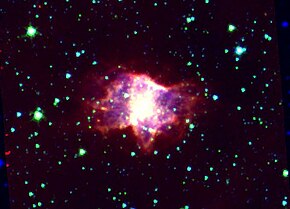This article needs additional citations for
verification. (July 2021) |
| Emission nebula | |
|---|---|
| Planetary nebula | |
 A
Spitzer Space Telescope image of NGC 6072 | |
| Observation data: J2000 epoch | |
| Right ascension | 16h 12m 58.363s [1] |
| Declination | −36° 13′ 47.40″ [1] |
| Distance | 3,060
ly (939
pc)
[1] 3,320 ly (1,017 pc) [2] ly |
| Apparent magnitude (V) | 14 [3] |
| Apparent dimensions (V) | 70 ″ [2] |
| Constellation | Scorpius |
| Designations | IRAS F16097-3606, NGC 6072 [4] |
NGC 6072 is a planetary nebulae in the southern constellation of Scorpius. It has a dynamical age of 104 years. Its circumstellar envelope is likely to be rich in carbon as it has very strong CN ( cyanide) spectral lines. CN spectral lines are generally not detected in oxygen rich AGB ( asymptotic giant branch) circumstellar envelopes. NGC 6072 also shows H2 ( hydrogen) emission and intense CO ( carbon monoxide) emission which has been mapped displaying bipolarity and some gas at high velocity. The evolution of this planetary nebulae is likely to be dominated by photodissociation and ion/ radical molecular reactions. Shock chemistry is also likely to be important.
An analysis of Gaia data suggests that the central star is a binary system. [5]
References
- ^ a b c Brown, A. G. A.; et al. (Gaia collaboration) (August 2018). "Gaia Data Release 2: Summary of the contents and survey properties". Astronomy & Astrophysics. 616. A1. arXiv: 1804.09365. Bibcode: 2018A&A...616A...1G. doi: 10.1051/0004-6361/201833051. Gaia DR2 record for this source at VizieR.
- ^ a b Stanghellini, L.; et al. (2008). "The Magellanic Cloud Calibration of the Galactic Planetary Nebula Distance Scale". The Astrophysical Journal. 689 (1): 194–202. arXiv: 0807.1129. Bibcode: 2008ApJ...689..194S. doi: 10.1086/592395. S2CID 119257242.
- ^ "Students for the Exploration and Development of Space". Results for NGC 6072. Archived from the original on December 28, 2012. Retrieved 2009-03-21.
- ^ "NGC 6072". SIMBAD. Centre de données astronomiques de Strasbourg. Retrieved 2022-01-01.
- ^ Chornay, N.; et al. (2021). "Towards a more complete sample of binary central stars of planetary nebulae with Gaia". Astronomy & Astrophysics. 648: A95. arXiv: 2101.01800. Bibcode: 2021A&A...648A..95C. doi: 10.1051/0004-6361/202140288. S2CID 230770301.
External links
-
 Media related to
NGC 6072 at Wikimedia Commons
Media related to
NGC 6072 at Wikimedia Commons